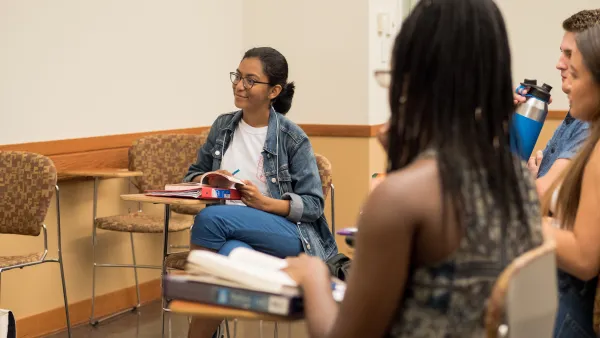A thoroughly vetted list of 11 core skills, or literacies, will guide Arts & Sciences classrooms and prepare students to thrive as engaged citizens post-graduation.
As a cognitive psychologist and professor of education who studies the different ways in which people learn, Andrew Butler has followed the Literacies for Life and Career initiative ever since it launched in 2021 as part of the Arts & Sciences Strategic Plan.
Literacies for Life and Career (LLC) began with an ambitious goal: to identify the core skills, or literacies, that an arts and sciences education provides to students, and then to emphasize those skills throughout their undergraduate education. By the end of their time at WashU, students would be able to clearly articulate the value of those literacies, and then apply them toward their post-graduate lives and careers.
“I thought it was a really interesting attempt within Arts & Sciences to start to think about some of the things we do for all of our students,” Butler said. “The promise of this initiative is that it could really evolve and reinvigorate teaching as well as the undergraduate experience.”
Literacies was, in short, a natural fit for Butler’s expertise and interests. So when the program needed to assemble a core team of faculty to push its proposed list of literacies over the finish line, Butler was one of the first people contacted.
This summer, Butler joined colleagues Tabea Alexa Linhard and Richard Mabbs as members of an LLC faculty task force. They worked alongside Associate Dean and Director of Student Academic Affairs Robert Pampel, who provided feedback on how academic advising could play a role in reinforcing literacies for students.
Their goal was to sift through a small mountain of evidence gathered across the first year of faculty piloting literacies-based instruction in Arts & Sciences classrooms, and then make recommendations on how to clarify and consolidate existing programmatic elements. Their feedback would prove essential as the Literacies program enters its third year of implementation, building toward an eventual scale-up into all Arts & Sciences undergraduate courses.
“It was a gift to have the task force come in at this crucial moment to look closely at all of the feedback with fresh eyes,” said Michelle DeLair, director of curricular innovation for Arts & Sciences. “I think they realized quickly what a daunting task it presented, but they committed to the process and produced thoughtful recommendations to improve the legibility of the individual literacies and the list as a whole for faculty and students.”
Working at a sprint across a handful of days, Butler, Linhard, Mabbs, and Pampel had plenty to discuss.
“Here’s what’s working, here’s what’s not working, here are all these surveys we’ve done, here are studies of peer institutions and what they’ve done,” Butler said of the materials on hand. “We asked ourselves, ‘How can we do something unique and distinctive here? And how can we make sure that these literacies are something that every faculty in Arts & Sciences can buy into?’”
That question of faculty buy-in has been a front-of-mind concern for LLC from the onset. In its slow march toward conceiving, piloting, and finalizing its list of educational literacies, the group’s leadership has emphasized a bottom-up approach driven by faculty feedback.
“These literacies come from Arts & Sciences faculty and Arts & Sciences courses,” said Erin McGlothlin, vice dean of undergraduate affairs in the College of Arts & Sciences and co-director of the Literacies initiative. “We did not hire consultants. There’s no outside person who told us what we need to have in our curriculum or what we should be doing. In fact, these literacies are already present, if somewhat obliquely, in our courses. We’re just drawing them out and framing them differently for our students.”
Butler has seen what the alternative looks like at other institutions – and it isn’t pretty.
“A lot of schools that do things similar to this are just putting window dressing on stuff, but it doesn’t have any actual meaning,” Butler said.
The challenge, then, was to consider the wide variety of perspectives that Arts & Sciences faculty bring to their teaching. What would professors who teach chemistry and music composition have in common, for example? What were the truly essential ideas that could unite their work and benefit students?
Asking those kinds of elemental questions helped Butler, Linhard, Mabbs, and Pampel to narrow down the initial list of 14 provisional literacies to a final list of 11.
“We found that some of the literacies could be folded into each other—we had more than we probably needed,” Butler said. “One of the things we tried to do was think about the hierarchies of learning objectives, and make sure that all the literacies were on the same level.”
This final list, approved by Literacies leadership and its steering commitee, will guide the 26 Arts & Sciences faculty who will pilot literacies in their classrooms during the 2024-2025 academic year:
- Applied problem solving
- Collaboration and leadership
- Communication dexterity
- Creative and innovative practices
- Critical and interpretive skills
- Ethical reasoning
- Historical and social understanding
- Integrative thinking
- Intercultural and global fluency
- Data analysis
- Systematic inquiry
The next steps for LLC are more akin to giant leaps: the program aims to apply its literacies to all first-year courses in 2025-2026, and then to all Arts & Sciences courses generally in 2026-2027.
While acknowledging the big lift ahead of her and her team, McGlothlin is encouraged by the faculty excitement surrounding the program, and has seen firsthand the benefit from applying literacies to her own teaching.
“In my first-year course, part of the Ampersand Program on the Holocaust, I’ve really doubled down on ethical reasoning and brought that through in more intentional ways,” McGlothlin said. “It’s given an added spark to my teaching and the course itself. I always thought that what I was teaching had ethical implications, but I don’t know if past students would have said, ‘I’m learning about ethics from this course.’ I think they’re more likely to say that now.”




